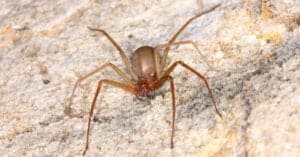Montana is a state with many names: The Treasure State, the Big Sky State, and The Last Best Place. Many of these names refer to the state’s natural beauty. Montana is home to many plants and animals including pronghorn deer and grizzly bears. The state is also home to its fair share of spiders. From cobweb spiders to orb weavers, you can find many kinds of spiders in Montana. Here is a list of 10 spiders in Montana that no spider lover will want to miss.

#10. Red-Backed Jumping Spider
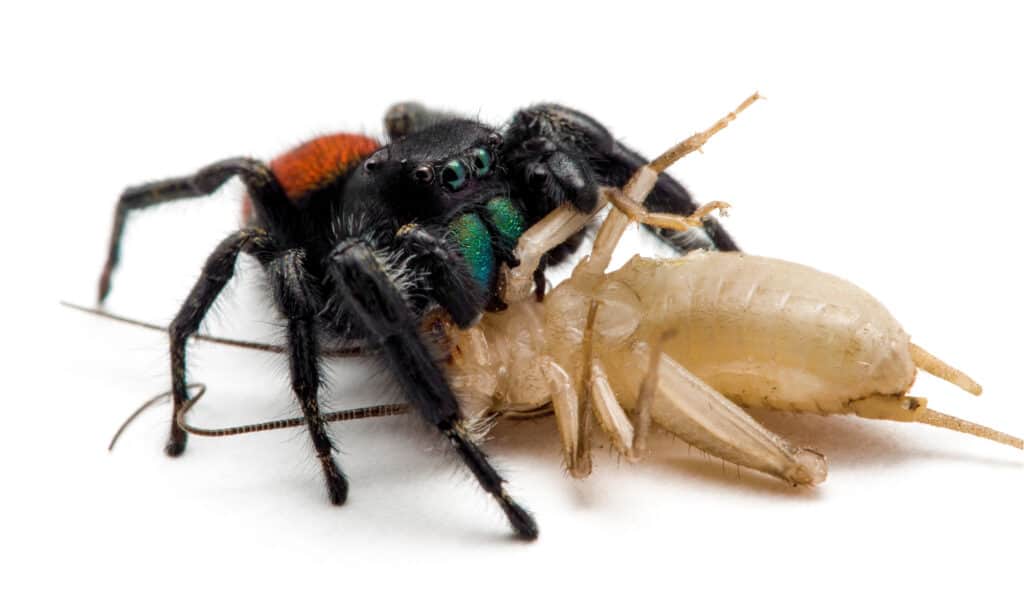
Female red-backed jumping spiders will occasionally cannibalize the males.
©Ernie Cooper/Shutterstock.com
Phidippus johnsoni, or the red-backed jumping spider, is one of the most notable jumping spiders in Montana. A member of the family Salticidae, it ranges widely throughout western North America from Canada to Mexico.
Adult red-backed jumping spiders typically measure around 10 millimeters long, with females measuring larger than males. They feature large, bright teal mouthparts and characteristic bright red abdomens, hence their name. You can differentiate the females from the males by the black stripe down the center of their abdomens.
Red-backed jumping spiders do not build webs to catch prey. Instead, they emerge from hidden retreats during the day to hunt down flies, moths, ants, and even other spiders. Females will also occasionally cannibalize males. In general, they tend to not act aggressively toward humans and their bite is not medically significant.
#9. Forest Wolf Spider
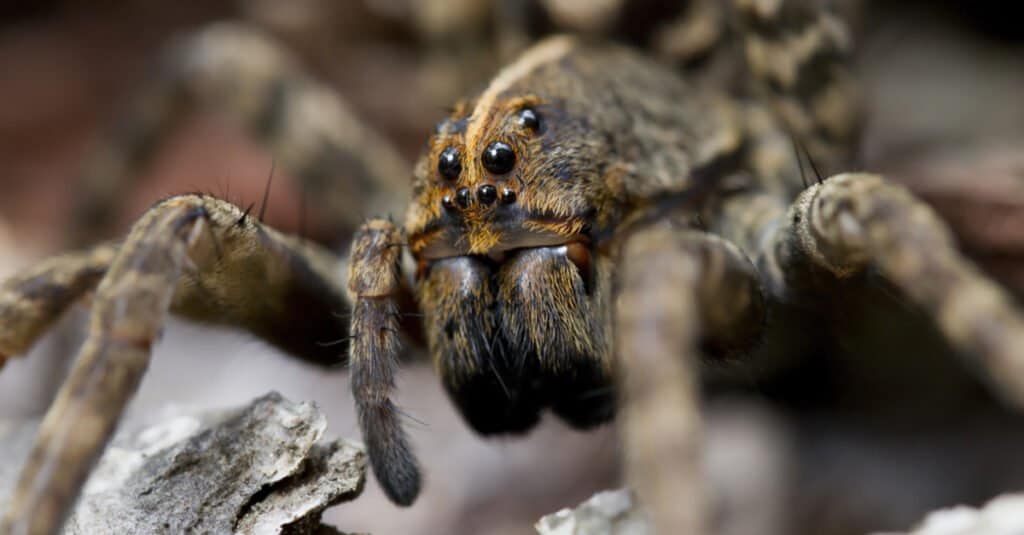
The forest wolf spider can reach nearly 50 millimeters long with its legs extended.
©Will E. Davis/Shutterstock.com
The forest wolf spider, Hogna frondicola, belongs to the wolf spider family Lycosidae. You can find these spiders in Montana as well as throughout most of the United States and Canada.
Adult forest wolf spiders can measure 50 millimeters with their legs extended. That said, females typically measure larger than males. Like other wolf spiders, forest wolf spiders possess long, powerful legs that allow them to run quickly. They sport a wide, light grey stripe down the center of the carapace. The rest of the carapace appears dark grey while the abdomen is also light grey.
Forest wolf spiders do not use webs to capture prey and instead rely on their keen eyesight and agility. At night, they wander the forest floor in search of insects and other spiders and retreat to underground burrows during the day. While their bites can be painful they are otherwise not medically significant.
#8. Marbled Orb Weaver
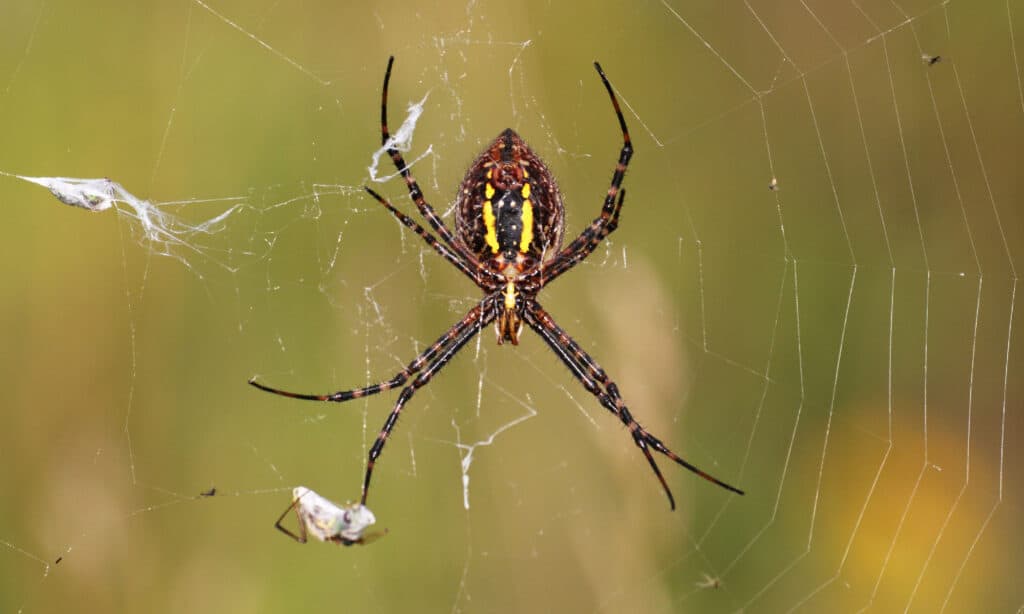
The marbled orb weaver features striking markings on its abdomen.
©iStock.com/mirceax
The marbled orb weaver, Araneus marmoreus, also goes by the name the pumpkin spider. It belongs to the orb weaver family Araneidae and is common in wooded areas throughout North America.
Adult females measure up to 18 millimeters long while males typically only measure around 9 millimeters long. The name pumpkin spider refers to their large, orange abdomens with dark markings which look somewhat like giant pumpkins. That said, some specimens instead appear pale yellow aside from a dark patch near the rear.
Marbled orb weavers construct vertically-oriented webs that they use to catch prey. During the day, they hide in silken retreats located in the corner of their webs. Like other orb weavers, they rarely act aggressively towards humans and their bite is not medically significant.
#7. Mouse Spider
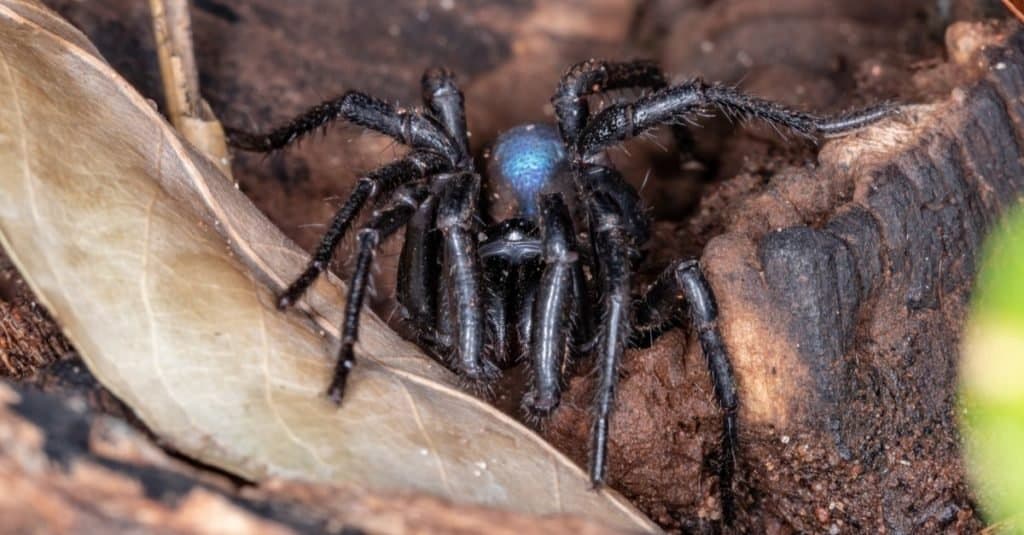
Mouse spiders make quick, erratic movements sort of like a mouse.
©Vinicius R. Souza/Shutterstock.com
Scotophaeus blackwalliis, or the mouse spider, belongs to the ground spider family Gnaphosidae. You can find these spiders in Montana as well as throughout the western United States and parts of Europe. Despite its name, it is not closely related to the venomous mouse spiders of Australia and Chile.
Female mouse spiders can grow up to 12 millimeters long and males can measure nearly 9 millimeters in length. They tend to move with quick, darting movements, which faintly resemble the movements of mice. Their carapaces look dark brown while their abdomens appear velvety-grey. This texture is another reason for their common name.
Like other ground spiders, mouse spiders do not use webs to capture prey. Instead, they are active hunters that will also readily scavenge for dead insects and other spiders. They hunt by using their sticky silk as a web to tackle their prey.
#6. Rabbit Hutch Spider
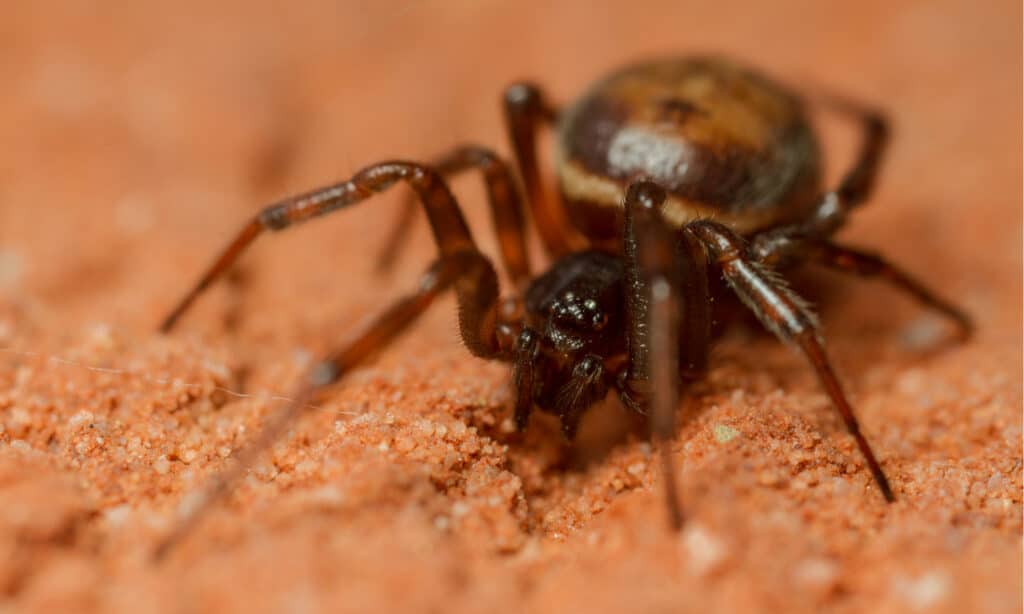
The rabbit hutch spider frequently likes to make its webs in rabbit hutches, hence its name.
©thatmacroguy/Shutterstock.com
Steatoda bipunctata, or the rabbit hutch spider, belongs to the cobweb spider family Theridiidae. It gets its name from the fact that it commonly makes its home in rabbit hutches, sheds, and basements. You can find these spiders in Montana as well as throughout North America and Europe.
Adult rabbit hutch spiders rarely measure more than 7 millimeters long, with females measuring slightly larger than males. They possess large, brown abdomens that feature one pale, whitish line down the middle and another across the front. You can differentiate females from males due to their glossy sheen. Many people mistake them for black widows, which is why they and other members of their genus, Steatoda, sometimes go by the name false widows.
Rabbit hutch spiders build tangled cobwebs that they use to capture their prey. Due to their small size, their fangs usually can’t pierce human skin.
#5. Deadly Ground Crab Spider

Ground carb spiders are small and widely distributed across the United States.
©HWall/Shutterstock.com
The deadly ground crab spider, Xysticus funestus, is a member of the crab spider family Thomisidae. It is one of the most common crab spiders in Montana and ranges throughout much of the United States, Canada, and Mexico.
Adult females generally measure around 10 millimeters long while males measure about half that size. They typically appear orange with dark markings on their abdomens. Their name comes from their long, curved legs and ability to walk forward, sideways, and backward like a crab.
Deadly ground crab spiders utilize their long legs to snag unsuspecting insects that wander too close. Despite its intimidating name, their bite poses little to no danger to humans. Most bites cause only mild pain or swelling which tends to subside within a few days.
#4. Western Black Widow

Western black widows rarely engage in cannibalism, unlike some of their fellow widows.
©Jay Ondreicka/Shutterstock.com
Latrodectus hesperus, or the western black widow, is one of the most venomous spiders in Montana. It belongs to the cobweb spider family Theridiidae and ranges throughout the western half of North America.
Female western black widows measure from 14 to 16 millimeters long while males measure about half that size. Their bodies appear mostly glossy black aside from a red hourglass-shaped marking on the bottom of their abdomens. That said, this marking can also appear yellow or — in some circumstances — white.
Black widows get their name from the females’ habit of cannibalizing the males. However, unlike some of its cousins, the Western black widows rarely engage in cannibalism. It builds an irregularly-shaped cobweb made of hanging, sticky threads that it uses to entangle its prey. Its venomous bite causes symptoms that include pain, fever, nausea, and sweating. On rare occasions, bites can prove fatal in young or immunocompromised people.
#3. Red-Spotted Ant Mimic
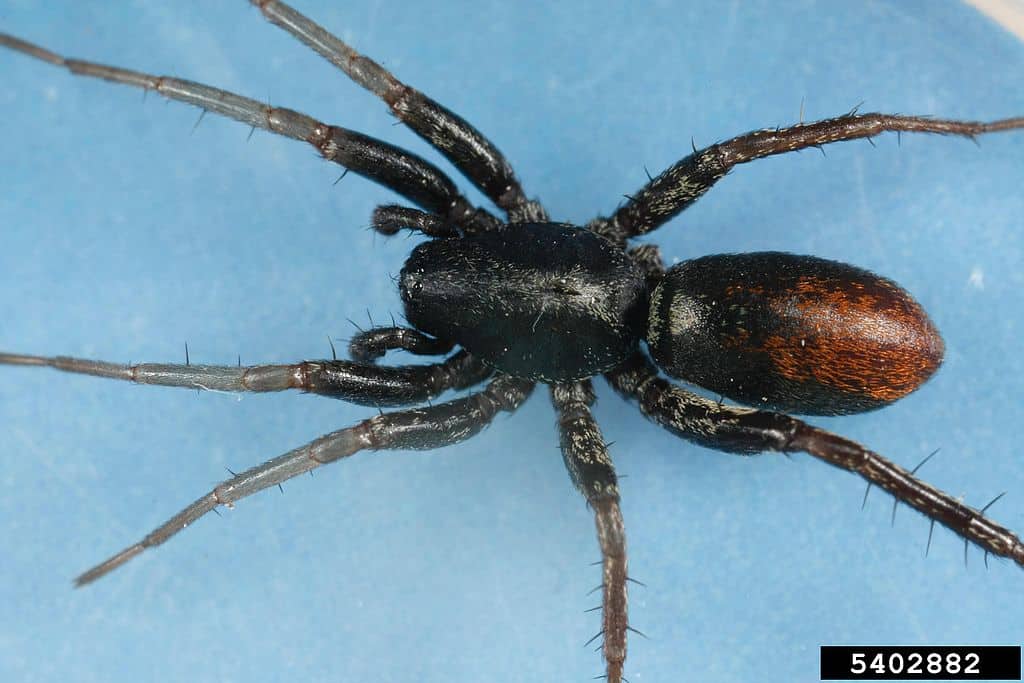
The red-spotted ant mimic acts like an ant in order to sneak up on its prey.
©Joseph Berger, Bugwood.org; University of Georgia / CC BY 3.0, via Wikimedia Commons – Original / License
The red-spotted ant mimic, Castianeria descripta, belongs to the corrinoid spider family Corinnidae. It ranges throughout the United States. If you want to find these curious spiders in Montana, you’ll most likely encounter them in shrubs or wooded areas near anthills.
Female red-spotted ant mimics generally measure around 13 millimeters long while males measure slightly smaller. They appear mostly black aside from a reddish-brown mark on their abdomens. People sometimes mistake them for black widows due to their similar size and shape. Thankfully, you can differentiate them by the characteristic white line down the center of the red-spotted ant mimic’s carapace.
Red-spotted ant mimics do not use webs to capture their prey. On the contrary, they are active hunters that rely on deception. They mimic the appearance of an ant by walking on six legs and using their front two legs like antennae, hence their name.
#2. Hobo Spider
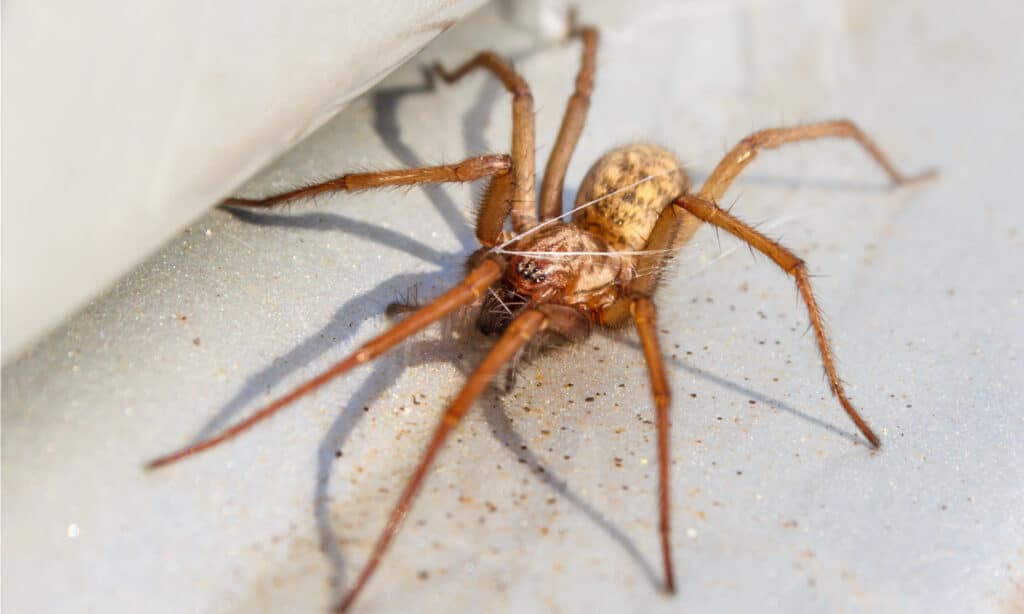
The hobo spider is rumored to hitch rides on cars and other vehicles, hence its name.
©Andrew Balcombe/Shutterstock.com
Tegenaria agrestis is more commonly known as the hobo spider. A member of the funnel web spider family Agelenidae, it ranges throughout parts of North America, Europe, and Central Asia.
Adult hobo spiders generally measure from 7 to 14 millimeters long with males tending to measure smaller than females. They appear predominantly brown except for several V-shaped markings down the center of their abdomens. Additionally, they typically feature a light stripe in the middle of their sternums.
Hobo spiders construct funnel-shaped webs that they use to catch prey. Their favored tactic entails waiting in the back of their webs for insects to mistakenly stumble inside before rushing in for the kill. Despite their ferocious appetites, they rank as one of the most misunderstood spiders in Montana. Many people mistakenly believe them to possess deadly poison, when in reality their bite poses little threat to humans.
#1. Candy-Striped Spider

The common candy-striped spider has red stripes along its body that look like candy stripes.
©iStock.com/Ines Carrara
The common candy-striped spider, Enoplognatha ovata, is the third member of the family Theridiidae to make our list of spiders in Montana. Although it is native to Europe, it now ranges throughout parts of the United States and Canada.
Female common candy-striped spiders generally measure about 6 millimeters long while males measure slightly smaller. They appear light green, cream, or white in color, while their legs look almost translucent. Their name comes from the red stripes that run down their abdomens that look a lot like candy stripes.
Common candy-striped spiders spin irregularly-shaped cobwebs that they use to ensnare their prey. Despite their small size, they are proficient hunters and frequently capture and kill much larger insects. Their bite poses little threat to humans and normally only causes some mild pain and swelling.
Summary of the 10 Spiders in Montana
Here’s a recap of the 10 species of spiders in the state of Montana that we took a look at.
| Number | Spider | Size |
|---|---|---|
| 1 | Candy-Striped Spider | 6 millimeters |
| 2 | Hobo Spider | 7-14 millimeters long |
| 3 | Red-Spotted Ant Mimic | 13 millimeters long |
| 4 | Western Black Widow | 14-16 millimeters long (female) |
| 5 | Deadly Ground Crab Spider | 10 millimeters long |
| 6 | Rabbit Hutch Spider | 7 millimeters long |
| 7 | Mouse Spider | 12 millimeters long (female); 9 millimeters long (male) |
| 8 | Marbled Orb Weaver | 18 millimeters long (female); 9 millimeters long (males) |
| 9 | Forest Wolf Spider | 50 millimeters long |
| 10 | Red-Backed Jumping Spider | 10 millimeters long |
Thank you for reading! Have some feedback for us? Contact the AZ Animals editorial team.






